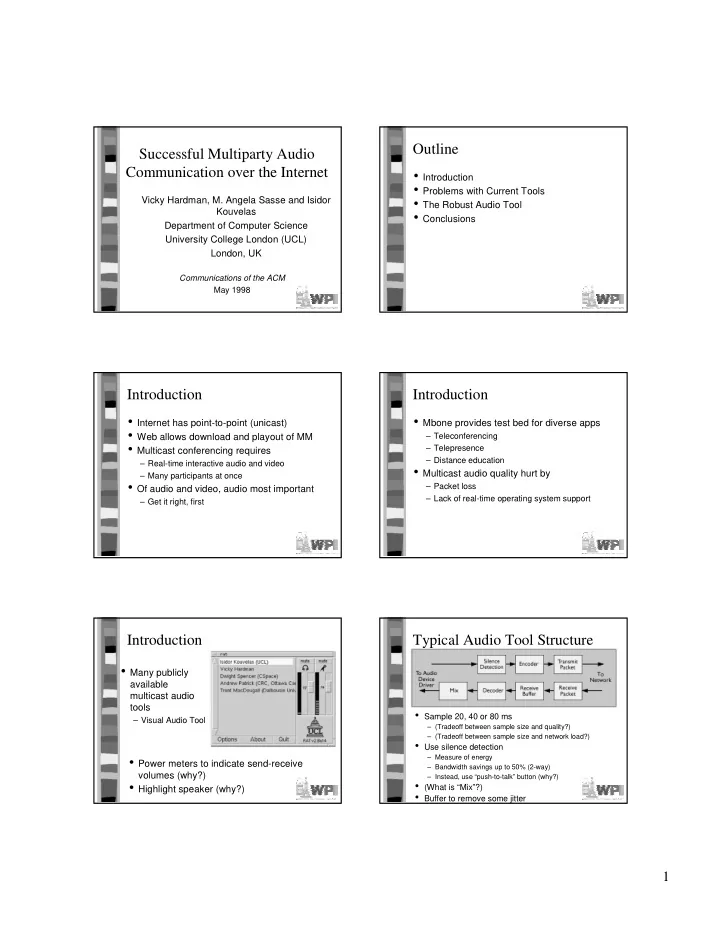

Outline Successful Multiparty Audio Communication over the Internet • Introduction • Problems with Current Tools Vicky Hardman, M. Angela Sasse and Isidor • The Robust Audio Tool Kouvelas • Conclusions Department of Computer Science University College London (UCL) London, UK Communications of the ACM May 1998 Introduction Introduction • Internet has point-to-point (unicast) • Mbone provides test bed for diverse apps • Web allows download and playout of MM – Teleconferencing • Multicast conferencing requires – Telepresence – Distance education – Real-time interactive audio and video • Multicast audio quality hurt by – Many participants at once • Of audio and video, audio most important – Packet loss – Lack of real-time operating system support – Get it right, first Introduction Typical Audio Tool Structure • Many publicly available multicast audio tools • Sample 20, 40 or 80 ms – Visual Audio Tool – (Tradeoff between sample size and quality?) – (Tradeoff between sample size and network load?) • Use silence detection – Measure of energy • Power meters to indicate send-receive – Bandwidth savings up to 50% (2-way) volumes (why?) – Instead, use “push-to-talk” button (why?) • (What is “Mix”?) • Highlight speaker (why?) • Buffer to remove some jitter 1
Acoustic Problems with Existing Problems with Existing Tools Tools • Delay not usually a big problem • Echoes and feedback – Typically under 400-600 ms – Push-to-talk helps, but not silence detection • Loss can be problematic • Silence detection – 10% is max tolerable with silence substitution – Clips words, may pick up background noise • Lack of distance cues – International links typically have 20-25% loss • No real-time OS support – Causes mismatch of volume • Restricted intelligibility – Processes to send-receive may not be scheduled in time, leading to gaps in playout – Caused by mere toll quality audio (?) • Monaural sound – Hard to identify speakers The Robust-Audio Tool Repair in RAT • Has ‘hands-free’ design – Speech detection • Up to 20% loss ok • Workstation scheduling features (we’ll cover) – 30% with waveform • Loss seen as most significant (not shown) – Uses redundancy to repair + Linear Predictive Encoding (LPC) for secondary frame – Multiple loss repaired through waveform substitution on second packet + Brain can smooth over Interface in RAT Silence Detection in RAT • Uses simple energy measure – Supplement with ‘rule-based’ approach(?) • Adaptive silence threshold – For changing background noise • Works so well, do not need ‘push-to-talk’ feature • Video and shared whiteboard • Audio and video separate, so need synch • Power-meter for volume 2
Future Work? Conclusions and Future Work • Multicast has potential, but problems to fix • RAT fixes loss, has improvements to interface • Loss now ok, acoustic problems next – (A previous paper demonstrated this) • Need to have responsive protocols – (Our previous topic) – Use alternate encoding to reduce rate • Network may use priority queuing to help – (Upcoming topic) 3
Recommend
More recommend